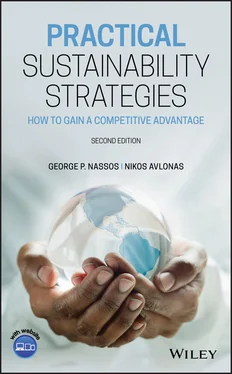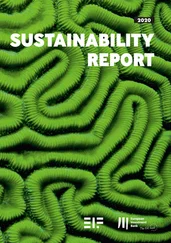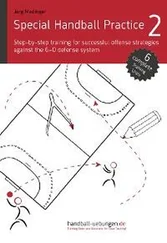Other examples include the destruction of forests to convert the land for agricultural use. The increase in demand for food has forced some nations to trade off forests for agricultural land. This condition can also be considered in violation for the production of ethanol from corn. The land needed for this industrial crop could also be used for food crops. Overharvesting of fish may eventually deplete the fish population to a level below which regeneration to its original level may be impossible.
System Condition 4—There Must Be Fair and Efficient Use of Resources with Respect to Meeting Human Needs
Basic human needs must be met with the most resource-efficient methods possible. Unless basic human needs are met worldwide through fair and efficient use of resources, it will be difficult to meet conditions 1, 2, and 3 on a global scale. As the human population continues to grow, it becomes more and more critical for the efficient use of the natural resources.
In 2019, the human population reached 7.7 billion and this will require even more consumption of the earth's natural recourses. This increase in population will lead to an increase in energy consumption, and with a finite quantity of available fossil fuels more efficient use of coal, oil, and natural gas will be necessary. More efficient use also means an increase in renewable energy development and consumption. More efficient use of these energy resources will satisfy System Condition 4. At the same time, by adopting as much renewable energy as possible, less carbon dioxide will be emitted into the ecosphere and this will satisfy System Condition 1.
The use of plastic beverage containers is continuing to increase as the population grows and as more people drink bottled water. Unfortunately, in 2016 over 480 billion beverage [6] containers were sold and about 79% accumulated in landfills [7]. It is critical that more efficient use of plastic beverage containers is adopted in order to use less of the natural resources in their manufacturing and satisfy System Condition 4. In addition, there will be less plastic containers in the ecosphere and thus satisfy System Condition 2.
As the population continues to grow, another negative impact is the continued increase in fish consumption. Fishing is central to the livelihood and food security of 200 million people, especially in the developing world, while one of five people on this planet depends on fish as the primary source of protein. According to the UN Food and Agricultural Organization [8] in 2015, two-thirds of the world's fish species are either fully exploited or depleted. The dramatic increase of destructive fishing techniques worldwide destroys marine mammals and entire ecosystems. More efficient harvesting of the fish population is critical in order to meet the needs of future generations and thus satisfy System Condition 4. By decreasing the fish population, the ability to increase the population will also diminish thus violating System Condition 3. This is another example of showing that meeting System Condition 4 is critical to meeting the other three conditions.
SCIENTIFIC RATIONALE FOR THE NATURAL STEP
There are four basic scientific principles that form the foundation for TNS framework [1]:
1 Matter and energy cannot be created or destroyed (according to the first law of thermodynamics and the principle of matter conservation). This means that the overall mass of the earth remains constant. We have the same volume of matter now as we did 4.5 billion years ago. Therefore, matter—or the earth's resources—only changes its form.
2 Matter and energy tend to disperse (according to the second law of thermodynamics). This means that sooner or later matter that is introduced into society will be released into natural systems. This is the underlying mechanism behind our experience that energy and material transformation operate to reduce the available energy in the system and increase the dissipation of matter throughout the system.
3 Material quality can be characterized by the concentration and structure of matter. What we consume are the qualities of matter and energy—the concentration, purity and structure of matter, and the ability of energy to perform work. Because nothing disappears and everything tends to disperse, a carpet turns to dust and a car turns to rust, and not the reverse. Dust does not reassemble into a carpet or rust into a car. As matter disperses, it loses its concentration, purity and structure.
4 The net increase in material quality on earth is produced by sun-driven processes. Photosynthesis is the only large-scale producer of material quality. While the earth is a closed system with regard to matter, it is an open system with respect to energy. This is the reason why the system has not already run down with all of its resources being converted to waste. The earth receives light from the sun and emits heat into space.
In addition to these scientific principles, TNS conditions are influenced by the cyclic principle that can be summarized as follows: (i) waste must not systematically accumulate in nature and (ii) the reconstitution of material quality must be at least as large as its dissipation.
THE NATURAL STEP RECENT PROJECTS
Interface—The First Company to Adopt the Natural Step
Interface became the first US company to adopt TNS framework and methodologies [9]. Under the guidance of TNS and other sustainability visionaries, a new vision for Interface was later crafted—Mission Zero™; to eliminate any negative impact Interface has on the environment by 2020, showing it is possible to create a better world, and being restorative by the power of our influence.
Interface included aspects from TNS's Framework for Strategic Sustainable Development (FSSD) in the company's strategic planning process and all employees training. Gradually the FSSD became a vital and visible part in the company's operations and culture, and it was consistently positioned as providing the most rigorous definition of sustainability.
From 1996 to 2013, Interface reduced the manufacturing waste it sends to landfill by 84%. About 49% of all raw materials are now either recycled or bio-based, including 36% of yarn and 51% of carpet backing. Savings from avoided waste costs amounted to US$450 million. In terms of energy, total energy use at the global factories has been reduced by 39% per unit. Also, 36% of energy consumed globally is from 100% renewable sources (with seven out of nine facilities operating with 100% renewable energy), and actual greenhouse gas emissions have been reduced by 41%. Interface, Inc. today uses only 20% as much water to make products as they did in 1996. This is an impressive accomplishment, especially for a materials manufacturer, and shows the benefits of looking at a business through the lens of sustainability.
Twenty-two years ago, Interface Inc. started on a journey led by their founder, Ray Anderson. The company adopted a bold new vision—“To be the first company that, by its deeds, shows the entire industrial world what sustainability is in all its dimensions: people, process, product, place and profits—and in doing so—become restorative through the power of influence.” Reaching this vision meant that Interface would need to evolve into an entirely different kind of organization, but there was no blueprint for this kind of organization in business.
Interface started by asking how they could translate the operations of nature into a model for business. They relied heavily on TNS Framework to guide their thinking as they mapped out how to change their business. Interface ultimately developed the Seven Fronts of sustainability—seven key areas where Interface would focus to remake their company. Over the last 22 years, Interface has followed these Fronts and made progress reducing the impacts of the company and its reliance on natural resources. This has included a strong focus on the manufacturing operations where they traditionally used large amounts of raw materials, energy, and water.
Читать дальше












